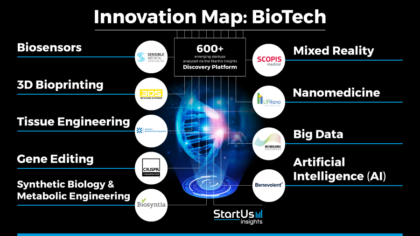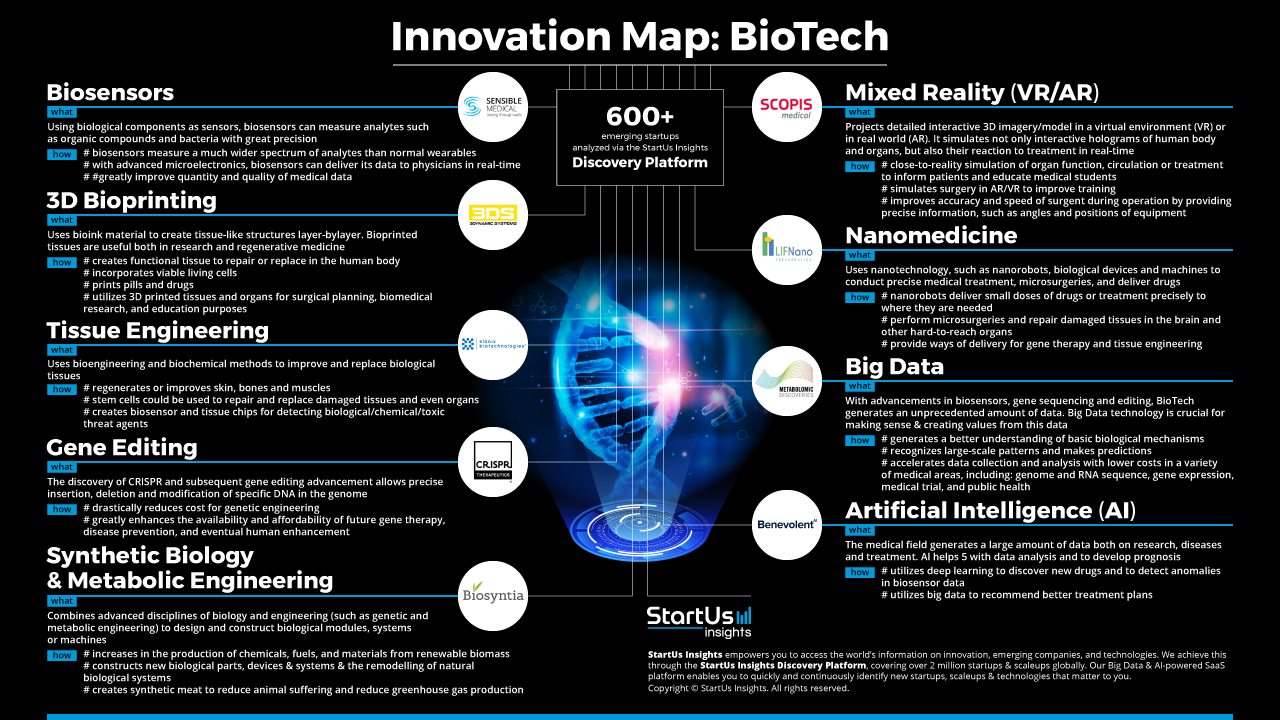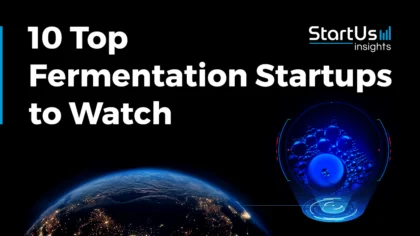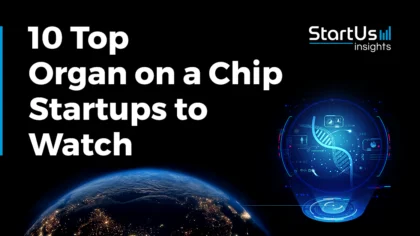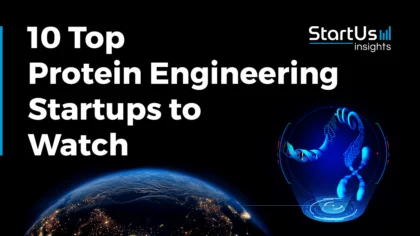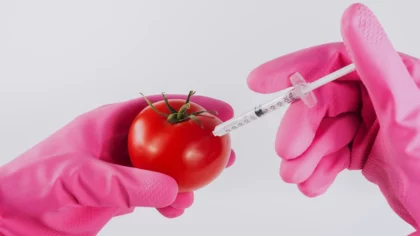Accelerate Productivity in 2025
Reignite Growth Despite the Global Slowdown
BioTech has evolved to be an exciting field for innovations, which will fundamentally change our understanding of medical care: Artificial Intelligence (AI) analysis data gathered from wearables and Biosensors help physicians to monitor the effect of treatment in real-time and to suggest improvements; 3D Bioprinted Nanorobots deliver antibiotics to the exact target to cure inflammation; Tissue Engineering fixes damaged parts of an organ without patients needing surgery; and Gene Therapy prevents many genetic diseases from even occurring.
This article was last updated in July 2024.
Dive into Our Data-driven BioTech Innovation Map
These are just some emerging BioTech applications that we at StartUs Insights have discovered, after analyzing more than 600 startups in the field. To give a better understanding of the future of biotechnology, we have clustered our findings in the BioTech Innovation Map:
Ready to explore all 600+ BioTech Startups & Scaleups?
Biosensors
Combining biological and electronic components, Biosensors measure and monitor many analytes such as organic compounds and bacteria with great precision. Since Biosensors are typically deployed inside a patient’s body, they are able to monitor analytes that cannot be measured by external devices. When equipped with advanced microelectronic components, Biosensors also function as a part of the Internet of Things (IoT) to deliver data to physicians in real-time.
3D Bioprinting
3D Bioprinting uses so-called “bioink” material to create tissue-like structures layer-by-layer. With appropriate bioink material, pills and drugs can be printed on-demand with much lower costs involved. Bioprinted tissues also have a wide range of usage in research and regenerative medicine, such as printing living cells, creating functional tissues to repair or replace organs.
Tissue Engineering
Tissue Engineering combines bioengineering and biochemical methods to improve, replace, or create biological tissues (i.e. bone, blood vessels, skin, muscle etc.). A more promising but controversial method is to use stem cells to grow and replicate entire organs of patients, without these patients needing transplants.
Gene Editing
Gene editing technology has been greatly enhanced by the early 2000s’ discovery and further development of using CRISPR-Cas9 for precise insertion, modification, and deletion of DNA sequences in the genome. It has made genetic engineering widely available at a fraction of the cost of earlier methods. CRISPR-Cas9’s applications not only allow physicians to perform affordable gene therapy but can also be used to prevent genetic diseases and potentially enhance human genetics.
Synthetic Biology & Metabolic Engineering
Combines advanced disciplines of biology and engineering (such as genetic and metabolic engineering) to design and construct biological modules, systems or machines. For example, Synthetic Biology is used to create synthetic meat to reduce animal suffering and greenhouse gas production; synthetic biology can also increase the production of chemicals, fuels, and materials from renewable biomass.
Looking for Specific BioTech Innovation Trends?
Mixed Reality (VR/AR)
Mixed Reality technologies are used to project a detailed interactive 3D simulation of human organs in a virtual environment (Virtual Reality) or in the real world (Augmented Reality). Mixed Reality simulates treatment or surgery that helps improve the effectiveness of training for surgeons and medical students. Augmented Reality can also measure the angles and positions of medical equipment and guide surgeons in real-time to improve the accuracy and speed of surgery.
Nanomedicine
Combined with 3D Bioprinting and Tissue Engineering, Nanotechnologies have a wide spectrum of applications in medicine. For example, a biochemical Nanorobot can deliver small doses of drugs to precise locations or organs to minimize side effects and improve the quality of treatment. Surgeons can use remote-controlled Nanorobots to perform microsurgeries and repair damaged tissues in hard-to-reach locations such as the brain, for example.
Big Data
With advancements in biosensors, gene sequencing, and editing, BioTech is generating an unprecedented amount of data. Big Data technology is crucial for making sense of and creating insights from the large amount of data generated in areas such as genome and RNA sequencing, medical trial,s and public health. It also helps physicians to recognize disease patterns and make better predictions as a result.
Artificial Intelligence (AI)
The medical field traditionally generates a large amount of data stemming from research, diseases, and treatment. AI detects patterns and makes predictions from clinical trials and other medical data much faster, allowing for more efficient development of new drugs or treatments. Implemented in hospitals, it also helps physicians to diagnose diseases faster and develop more effective treatment plans for patients.
Meet Some of the Disruptive BioTech Startups
- Israeli startup Sensible Medical creates high-tech vest monitors called SensiVest. The monitors use radar technology to detect the accurate amount of fluid in the lungs of heart failure patients and deliver the data to their doctors via secured cloud technology.
- Swiss Elanix Biotechnologies develops products for acute wound care and dermatological and gynecological applications. Founded in 2013, the startup works with patented progenitor cell technology to accelerate tissue growth and healing.
- Swiss CRISPR Therapeutics develops gene-based medicines for patients with serious diseases. Utilizing CRISPR-Cas9, the startup aims to cure diseases at the molecular level.
- Danish Biosyntia aims to replace chemical-based vitamin production with sustainable and fermentation-based processes. The startup’s screening technology accelerates the development of new natural ingredients like nutraceuticals, flavors, fragrances, and feed additives while saving costs.
- London-based BenevolentAI employs artificial intelligence and machine learning to accelerate and improve drug discovery. Through AI, the startup mines and analyzes biomedical information from clinical trial data and academic papers, to identify molecules that have failed in clinical trials, and to develop better combinations of compounds.
Explore Emerging BioTech Startups & Technologies
Even though BioTech innovations have been evolving rapidly, the industry has not yet reached its peak. Many other advanced technologies not mentioned in this Innovation Map will also provide crucial benefits to human health, some of which are Brain-Computer Interface (BCI), Bioplastics, and molecular diagnostics. Many of these innovations are spearheaded by medical startups.
How to quickly and safely advance development in these fields, and how to create synergy by combining these technologies are crucial understandings for companies to become BioTech innovation leaders. StartUs Insights provides innovation intelligence to help create synergy between cutting-edge BioTech startups and companies with solid clinical R&D foundations.

